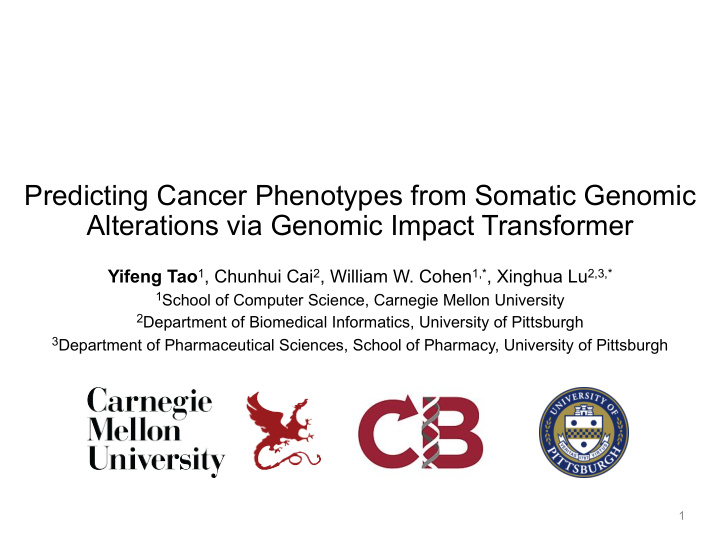



Predicting Cancer Phenotypes from Somatic Genomic Alterations via Genomic Impact Transformer Yifeng Tao 1 , Chunhui Cai 2 , William W. Cohen 1,* , Xinghua Lu 2,3,* 1 School of Computer Science, Carnegie Mellon University 2 Department of Biomedical Informatics, University of Pittsburgh 3 Department of Pharmaceutical Sciences, School of Pharmacy, University of Pittsburgh 1
Tumor origin and progression • Cancers are mainly caused by somatic genomic alterations (SGAs) • Driver SGAs (~10s/tumor): Promote tumor progression • Passenger SGAs (~100s/tumor): Neutral mutations • How to distinguish drivers from passengers? S Nik-Zainal et al. 2017 2
Cancer drivers • How to distinguish drivers from passengers? • Frequency: recurrent mutations more likely to be drivers B Vogelstein et al. 2013 ND Dees et al. 2012 MS Lawrence et al. 2013 • Conserved domain: protein function significantly disturbed B Reva et al. 2011 B Niu et al. 2016 • All unsupervised. But drivers are defined as mutations that promote to tumor development… 3
Cancer drivers • Identify driver SGAs with supervision of downstream phenotypes • Change of RNA expression • Differentially expressed Model (?) that genes (DEGs) predicts DEGs accurately • Candidate models & identifies driver SGAs • Bayesian model (C Cai et al. 2019) • Lasso/Elastic net (R Tibshirani 1994) • Multi-layer perceptrons (MLPs) (F Rosenblatt 1958) • Models do prediction & driver detection? 4
Self-attention mechanism • Models do prediction & driver detection? • Attention mechanism • Initially in CV (K Xu et al. 2015) /NLP (A Vaswani et al. 2017) Model with self-attention that • Better interpretability predicts DEGs accurately • Improves performance & identifies driver SGAs • Self-attention mechanism (Z Yang et al. 2016) 𝛽 ' 𝛽 ( = 1 𝛽 " 𝛽 # 𝛽 $ 𝛽 % 𝛽 & • Contextual deep learning framework: weights determined by all the input mutations 5
Genomic impact transformer (GIT) • Transformer: encoder-decoder architecture • Encoder: self-attention mechanism; Decoder: MLP 6
Encoder: Multi-head self-attention • Tumor embedding is the weighted sum of gene embeddings: • Weights determined by input gene embeddings: 7
Pre-training gene embedding: Gene2Vec • Co-occurrence pattern (e.g., mutually exclusive alterations) Pathway 1 g Pathway 3 c MD Leiserson et al. 2015 Pathway 2 T Mikolov et al. 2013 8
Improved performance in predicting DEGs • Predicting DEGs from SGAs • Conventional models • Ablation studies 63 79 61 78 59 77 Accuracy F1 score 57 76 55 75 53 74 51 73 9
Candidate drivers via attention mechanism 10
Gene embedding space • Functionally similar genes are close in gene embedding space • Qualitatively and quantitatively (i.e., GO enrichment, NN accuracy) 11
Tumor embedding: Survival analysis • Tumor embeddings reveal distinct survival profiles 12
Tumor embedding: Drug response • Tumor embeddings are predictive of drug response 13
Conclusions and future work • Biologically inspired neural network framework • Identifying cancer drivers with supervision of DEGs • Accurate prediction of DEGs from mutations • Side products • Gene embedding: informative of gene functions • Tumor embedding: transferable to other phenotype prediction tasks • Code and pretrained gene embedding: https://github.com/yifengtao/genome-transformer • Future work • Fine-grained embedding representation in codon level • Tumor evolutionary features, e.g., hypermutability, intra-tumor heterogeneity 14
Acknowledgments • Dr. Xinghua Lu • Dr. William W. Cohen • Dr. Chunhui Cai • Michael Q. Ding • Yifan Xue 15
Quantitative measurement of gene embeddings • Functional similar genes à closer in embedding space • Go enrichment: • NN accuracy: 11 10 NN accuray (%) 9 8 7 6 5 4 Random pairs Gene2Vec Gene2Vec+GIT 16
Tumor embedding space 17
Gene2Vec algorithm 18
Gene2Vec: Co-occurrence patterns • Co-occurrence does not necessarily mean similar embeddings • Ex 1: two cats sit there . • Ex 2: two cats stand there . • Ex 3: two dogs sit there . Pathway 1: two number one several Pathway 3: sit verb stand cat lie dog Pathway 2: MD Leiserson et al. 2015 T Mikolov et al. 2013 noun 19
Recommend
More recommend